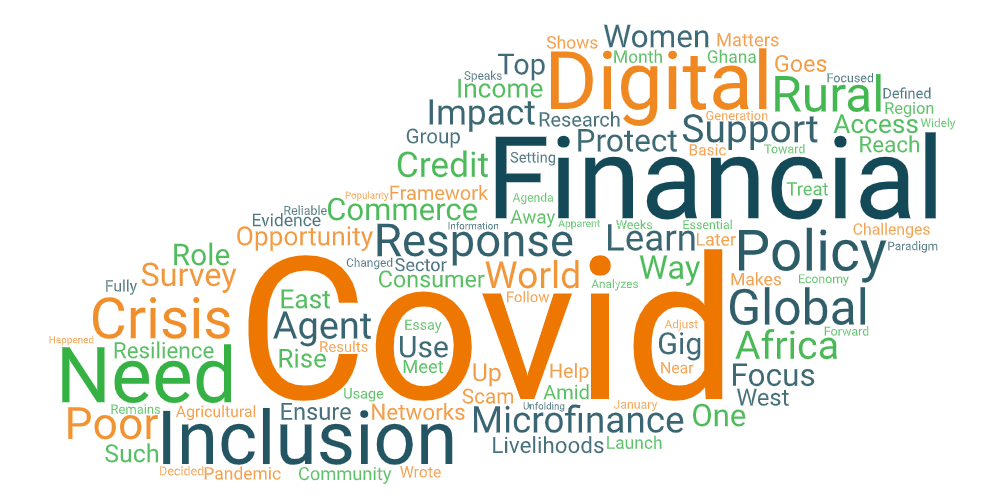Top 10 Blog Posts of 2020
In January 2020, CGAP CEO Greta Bull wrote a blog post setting out a new agenda for CGAP. Going forward, she explained, we would shift away from the access and usage paradigm that has defined financial inclusion for so long, toward a framework focused on how financial services can help poor people meet their basic needs in three areas: income generation, essential services, and resilience.
Then COVID-19 happened and plans changed. At least in part.
As Greta explained in her follow-up essay several weeks later, CGAP remains fully committed to our new framework. However, we decided to adjust our near-term plans to focus on supporting the COVID-19 response. That shift is apparent in this year’s most widely read blog posts, all but three of which relate to the crisis still unfolding around the world.
The popularity of these posts speaks to the ongoing need for reliable information about a crisis that is still affecting people’s lives in unprecedented ways. And although financial services are just one small piece of the puzzle, this year’s top blogs also reflect the financial inclusion community’s commitment to supporting an effective global response.

10. Agent Networks: Vital to COVID-19 Response, in Need of Support
Co-authored with the Bill & Melinda Gates Foundation, this post describes the role agents can play in the COVID-19 response and identifies challenges that policy makers must confront to ensure agent networks reach more people.
9. E-Commerce Is Taking Off in Rural China: 3 Lessons for Other Countries
China's e-commerce market has $2 trillion in annual sales and is growing as digital services reach rural areas. CGAP visited several villages and spoke with farmers and manufacturers about e-commerce. This blog shares what we learned about why e-commerce is taking off and the role of digital financial services.
8. Women in Rural and Agricultural Livelihoods Facing COVID-19
Women in rural and agricultural livelihoods have been disproportionately impacted by COVID-19. Taking the World Bank Group’s Gender Strategy as its lens, this post looks at how the pandemic has been affecting women’s economic opportunities, endowments (such as access to education and health care), and agency.
7. African Digital Credit Goes West
In 2019, CGAP raised consumer protection concerns around digital credit in East Africa. In CGAP’s first post of 2020, researchers took a critical look at the arrival of digital credit in neighboring West Africa. The post argues that despite early reports of lower default rates in the region, consumer protection policies are key to avoiding problems witnessed in East Africa.
6. Financial Inclusion for What?
Mixed evidence of financial inclusion’s impact has given rise to questions about whether financial inclusion matters. In the search for answers, CGAP’s starting point has been, “What matters to poor people?” We find that global evidence consistently shows that poor people use financial services to achieve two outcomes that improve their well-being: building resilience and capturing opportunities.
5. Financial Scams Rise as Coronavirus Hits Developing Countries
Unfortunately, cybercriminals have used COVID-19 as an opportunity to scam people with low incomes. What can be done to protect consumers and ensure they don’t lose trust in digital financial services at a time when such services are needed in the COVID-19 response? This blog makes some recommendations.
4. COVID-19 Exposes Risks and Opportunities in Kenya's Gig Economy
As part of CGAP’s ongoing research on Africa’s nascent gig economy and what it means for financial inclusion, CGAP interviewed platform workers in Nairobi, Kenya. Among the topics we asked them about was the impact of COVID-19 on their livelihoods. Read what we learned from them in this blog post.
3. Ghana Launches World’s First Digital Finance Policy Amid COVID-19
Amid COVID-19 In May 2020, Ghana became the first country CGAP is aware of to launch a digital financial services policy. While the policy had been years in the making, the government saw it as a way to support its COVID-19 response. Learn more about the policy in this blog post.
2. COVID-19: How Does Microfinance Weather the Coming Storm?
“If the microfinance sector is going to survive the pandemic, we need to treat it as the fundamental threat to the industry it likely is,” CGAP CEO Greta Bull writes in this post, which was published early in the crisis. She goes on to sketch out what it could look like for the microfinance sector to mobilize around an effective response.
1. Microfinance and COVID-19: Insights from CGAP's Global Pulse Survey
This year’s most-read “blog” is not a single post but a collection of posts. If treated individually, three of the blogs in this series would’ve made it into our top 10. So in the interest of diversity – and because these posts complement each other – they are grouped.
The series analyzes the results of CGAP’s six-month (June – December) survey of microfinance institutions, which gave the financial inclusion community its first look at how COVID-19 was impacting microfinance at global and regional levels. Among other things, the survey showed that the liquidity crisis many had feared in the early months of the crisis did not materialize, but that there was a need to focus on long-term challenges related to solvency and the effects of moratoria on both lenders and borrowers.
And with that, we say good-bye to 2020 here on the CGAP blog. See you in 2021.

Add new comment